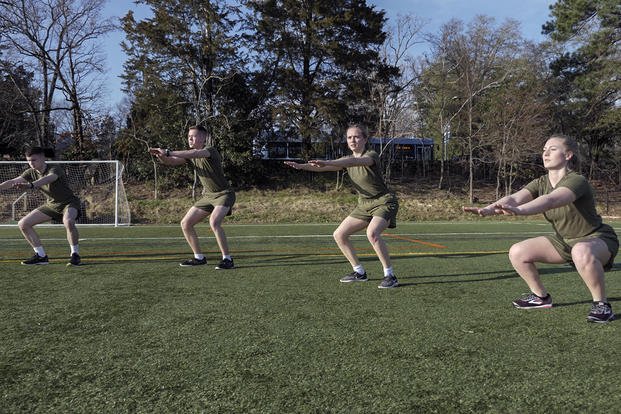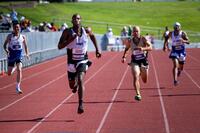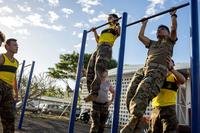Here is an article written by a friend of mine who understands common overuse injuries with athletes, as well as Special Operations training programs with regard to knee tendinitis that can shatter a military person's Special Ops dreams. Learn how to strengthen the legs and hips to help prevent nagging injuries, such as the iliotibial band, and add some lateral leg movements to your training.
BUD/S knee
The most common complaint of pain for a BUD/S candidate is pain stemming from the iliotibial band (ITB, or I Tried BUD/S). The ITB starts at the crest of the pelvis above the hip joint and runs to the outside of the knee. Attached to the ITB are the gluteus medius, quadriceps and hamstring muscles. Common issues with the ITB lead to lateral knee, hip and lower back pain. A common issue with tight quads is pain under the kneecap and tight hamstrings, often leading to lower back pain.
Cause
The main cause of knee, hip and lower back pain are well-developed and tight quadriceps, hamstrings and glutes. These muscle groups become tight due to increased development from a high frequency of running, running on unstable surfaces like sand and weightlifting.
These movements allow the hip to move forward and back but not side to side. The lack of side-to-side hip movement leads to muscle imbalance in the ITB and gluteus medius. The quads and hamstrings are strong, but the ITB and gluteus medius are weak.
The gluteus medius is the stabilizer of the pelvis. Weakness is exacerbated by running on soft sand. This may lead not only to ITB syndrome but also lower back pain within the sacroiliac joints (SI joints).
Stretching these muscles as well as strengthening as part of a well-rounded leg and glute program will go far in prevention and treatment of ITB, knee and SI joint pain.
Stretching
The hamstrings, glutes and quads need to be stretched. A standing quad stretch and hamstring stretch should be performed at the beginning and/or end of your workout; two sets each for 30 seconds each set daily.
The IT band needs to be stretched. The standing figure-four stretch and standing scissor stretch are best here. Again, two sets of 30 seconds before and after your workouts daily. Please see the links here for a demonstration of each stretch.
Hamstring stretch: https://www.youtube.com/watch?v=h0v6WbjbTMo
Quadriceps stretch: https://www.youtube.com/watch?v=CZBKSOtyssM
Abductor stretch: https://www.youtube.com/watch?v=1d80z3hBSh0
Strengthening
Perform monster walks with exercise bands wrapped around the lower legs. Do monster walks with a weight held overhead and a squat while pushing the knees out against the band each rep. Perform three sets of 30 reps each.
Standing abduction against a resistance. Wrap a cable from a machine around the ankle and, under a controlled movement, perform three sets each of 20 abduction exercises.
Lying on your side, wrap the exercise band around your ankles and perform lateral hip raises. Keep the knee and foot facing forward during the entire movement. And finally perform abduction exercises against the resistance of an exercise machine. Please see the attached link for a demonstration: http://www.youtube.com/watch?v=rtpJ-A7A-V4
Finally, the last issue a BUD/S candidate is likely to experience is SI joint pain. The SI joints are the joints that attach the pelvis to the spine on each side of the lower back. The gluteus medius muscles attach from here and insert into the ITB. These muscles stabilize lateral movement of the pelvis. Instability here can lead not only to ITB syndrome but also SI joint pain. Many people who get ITB also will experience lateral knee pain and SI joint pain.
To prevent SI joint pain, the monster walk exercises previously mentioned are great for strengthening and stretching. However, if the instability and pain are already apparent, strengthening may only hold the pelvis in an unstable position.
You do not want to strengthen a misaligned joint. If you are experiencing SI joint pain, I recommend a chiropractor for treatment before strengthening the stabilizers. Once the SI joints are aligned correctly, then a course of stretching and strengthening should begin. http://www.youtube.com/watch?v=1iwmcCw4bAw
About the Author
Stephen Erle is the strength and conditioning coach and team physician for a Virginia university. Erle instructs tactical athletics and specializes in sports medicine, nutrition and tactical combat casualty care medicine.
Stew Smith is a former Navy SEAL and fitness author certified as a Strength and Conditioning Specialist (CSCS) with the National Strength and Conditioning Association. Visit his Fitness eBook store if you're looking to start a workout program to create a healthy lifestyle. Send your fitness questions to stew@stewsmith.com.
Want to Learn More About Military Life?
Whether you're thinking of joining the military, looking for fitness and basic training tips, or keeping up with military life and benefits, Military.com has you covered. Subscribe to Military.com to have military news, updates and resources delivered directly to your inbox.



















